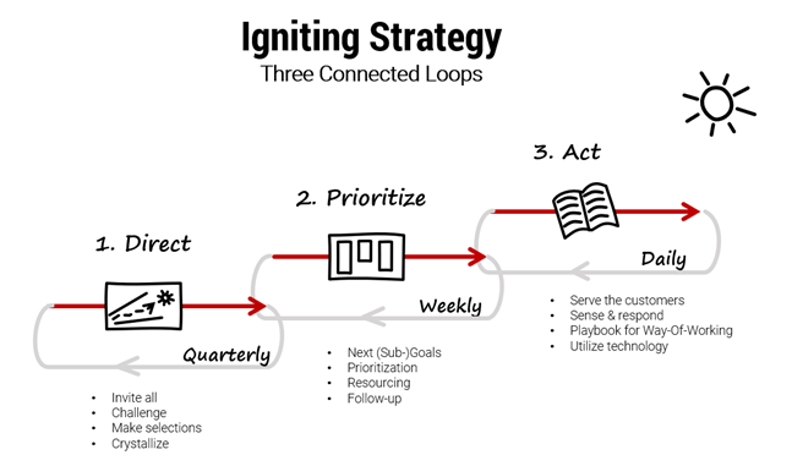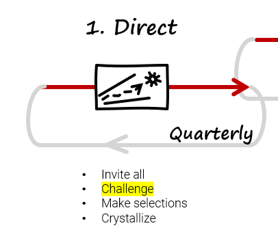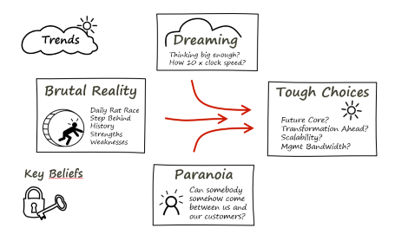
Challenging strategic thinking — 1.08
Markus Westerlund
Share this blog
Whether you are the CEO of the company or a leader of a department, we all have a problem, which makes us get stuck in a certain way of thinking. How to challenge strategic thinking? Let’s look at our model to see how a strategy is ignited.

We need three loops linked together, that rotate simultaneously. The third loop, ‘We Act’, rotates every day and in it, we serve our customers and solve their problems. The weekly rotating loop is ‘We Steer’, in which we steer and lead our everyday work. The question is, how do we make this work? How do we prioritize, set sub-goals, resource, and lead?
The slowest rotating loop in this model is ‘We Direct’, – Strategy design in other words.
The word ‘we’ in each loop means that we’re doing this together. Many companies make a bigger strategy round every few years. After the round, this loop should rotate quarterly in order to check up on the progress and update the strategy as needed.
Direct

Let’s look at the first loop more closely and how we can challenge our strategic thinking. In the previous blog I talked about the “include everyone” -loop and its points.
People don’t need to be involved through a separate process, because strategy implementation starts immediately, as if it happens by itself. I’ll tell you how to get people out of their comfort zone and challenge their current way of thinking.

This is a model we have used a lot and is in my opinion solid. Every box is its own workshop.
Trends
We have circulating trends that can either be black clouds or new opportunities. These trends should be looked at and conclusions made. We work together on a digital board, which makes its easy to choose the right trends to take into account.
Dreaming
Dreaming is a must. Do we think big enough? How could we work ten times faster? Everyone says it’s impossible. In the old way, yes. But what if we worked in a new way with new technology? It’s possible to work in a completely new way.
Dreaming is vital. Our job is to take the customer on a journey to the future. People in the company jump into a time machine and travel five years into the future. There they write a story about what they see and experience. With this story the company can find its vision and the great things they should take advantage of in the future.
Brutal Reality
During the Brutal Reality workshop we analyze everyday life, see what needs to be fixed and draw a conclusion.
Why are we in a constant rat race against the company’s development debt? The management thinks the company should be further than they are. Why are we not going forward? What should be fixed? This is a great challenge in every organization. What stops us from being better? Are we trying too hard?
Marmalade phenomenon
The Marmalade phenomenon is a great example. Every organization has a tablespoon of marmalade that represents their resources, including money, talent, factories, and office space. The management can decide how many pieces of toast are chosen:
If the company takes 32 pieces of toast and only a spoonful of marmalade, the toasts will taste mostly like bread, which means competing businesses will overtake the company in a heartbeat. Instead, what if the company chooses five, seven, or 12 pieces of toast? If they only pick one, there’s too much marmalade and the business should be downsized. What is the optimum amount of toasts for the company’s single spoon of marmalade?
It’s important to understand how many projects are going on at the same time. The management is performing badly if it doesn’t fill the calendars of its employees. However, it is also bad if it asks too much from them.
Paranoia
It’s important to also hold a Paranoia workshop. We need to dare and think about the right questions. Can somebody, in one way or another, come between us and our customer to steal our income stream from us?
I often hold intense exercises about how the business in question is completely destroyed. After that we think about how we save ourselves from this situation and also how great things are accomplished. We try to figure out what the competition is up to and how we respond to their performance. Again, all information is brought together and compressed into a Strategy 1Pager.
I think Uber is such a great example of disruption. First, the passenger called the dispatch to get a taxi. The dispatch gave the customer a number, but no information was given if a car was on its way and when it would arrive.
What did Uber do? It swam between the customer and taxi driver with digital technology, while showing on a map where the car is and when it arrives. No more waiting outside in the cold for a car to arrive, it’s enough to go out a minute earlier.
The same happened with Airbnb. Before there was a hotel and a guest. Airbnb offered private residences more affordably than a hotel. Hotels.com and ebookers also came between a traveler and a travel agency. Then, however, came Trivago, that came between ebookers, hotels.com and the customer and snatched everything.
Digital technology enables somebody to come between us and the customer while replacing us entirely.
Pretty dramatic, I’d say.
Tough decisions
When trends, dreaming, brutal reality and paranoia have been looked at, it’s time for tough decisions: prioritizing and prioritizing. What big things should we be doing?
One can say that every task we do is a lever that can be small, medium-sized, or really big. The question is about which choices we make, strategy means choices.
Will we focus on the same core business also in the future, or do we need to move onward higher up in the value chain? What transformation awaits us and when will it take place? It’s certain that a transformation will happen, but what is it and when will it take place? Will our values and culture work in the future as well?
In all of these processes, it is worth focusing on the variety of questions that you answer during the workshops.
I can say, that after facilitating close to a hundred strategy processes, this is absolutely a killer way of challenging people’s strategic thinking! Different, sure. The point is how you challenge an old operating system together with all of your colleagues and how you find amazing new opportunities thanks to the process. Enjoy!
Ignite your strategy! Read more.🔥
Recent Posts
Stradigo
Stradigo is a brand owned by Rdigo Oy (Business-ID: 2120844-1).
Learn more from our Imprint.
Rdigo Oy is registered in Finland as a Limited company. We are a strategy consultancy located in the Helsinki capital region.
We’ve been in business since 2007. The company name comes from the latin word Redigo, meaning both ‘I shape’ & ‘I renew’.
Stradigo combines the word strategy with Rdigo.